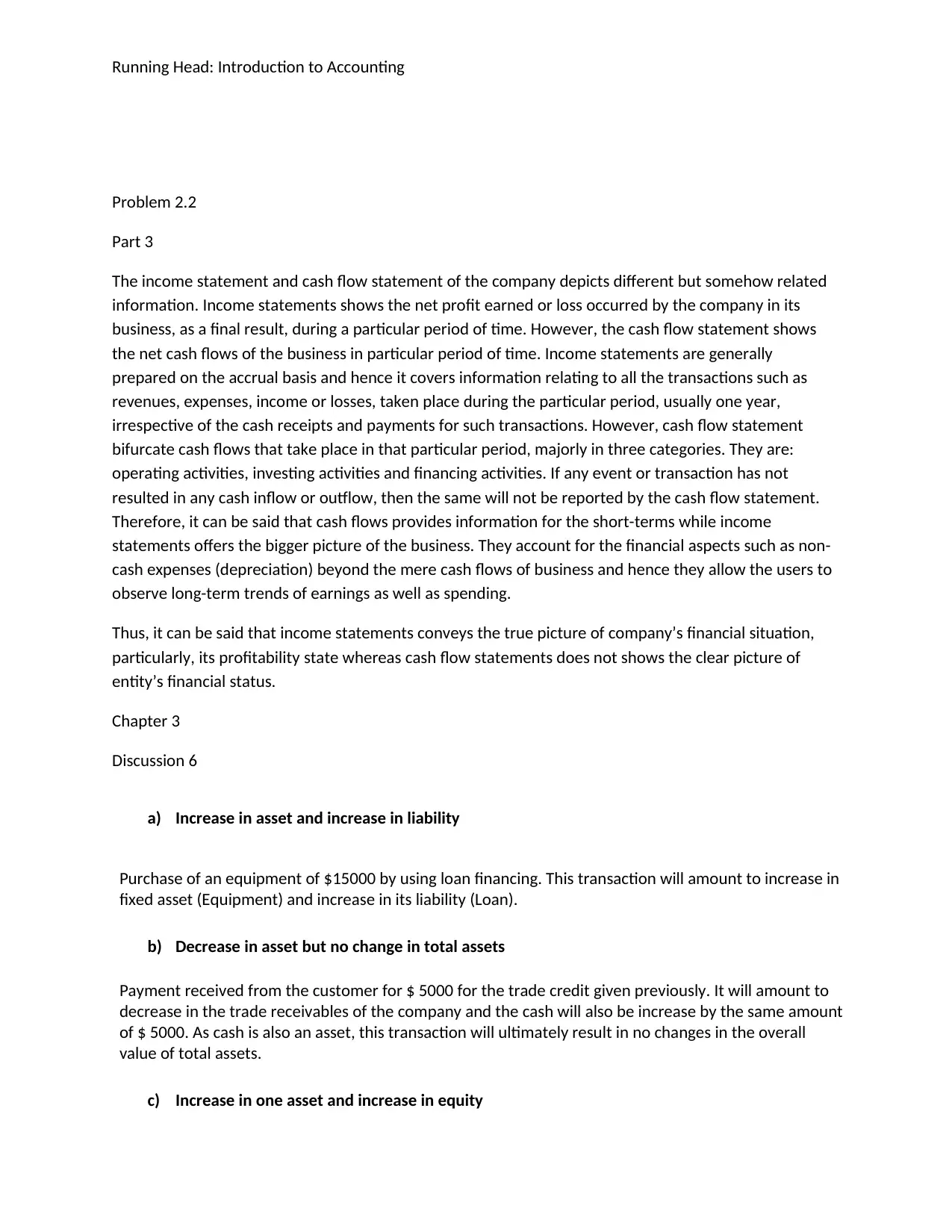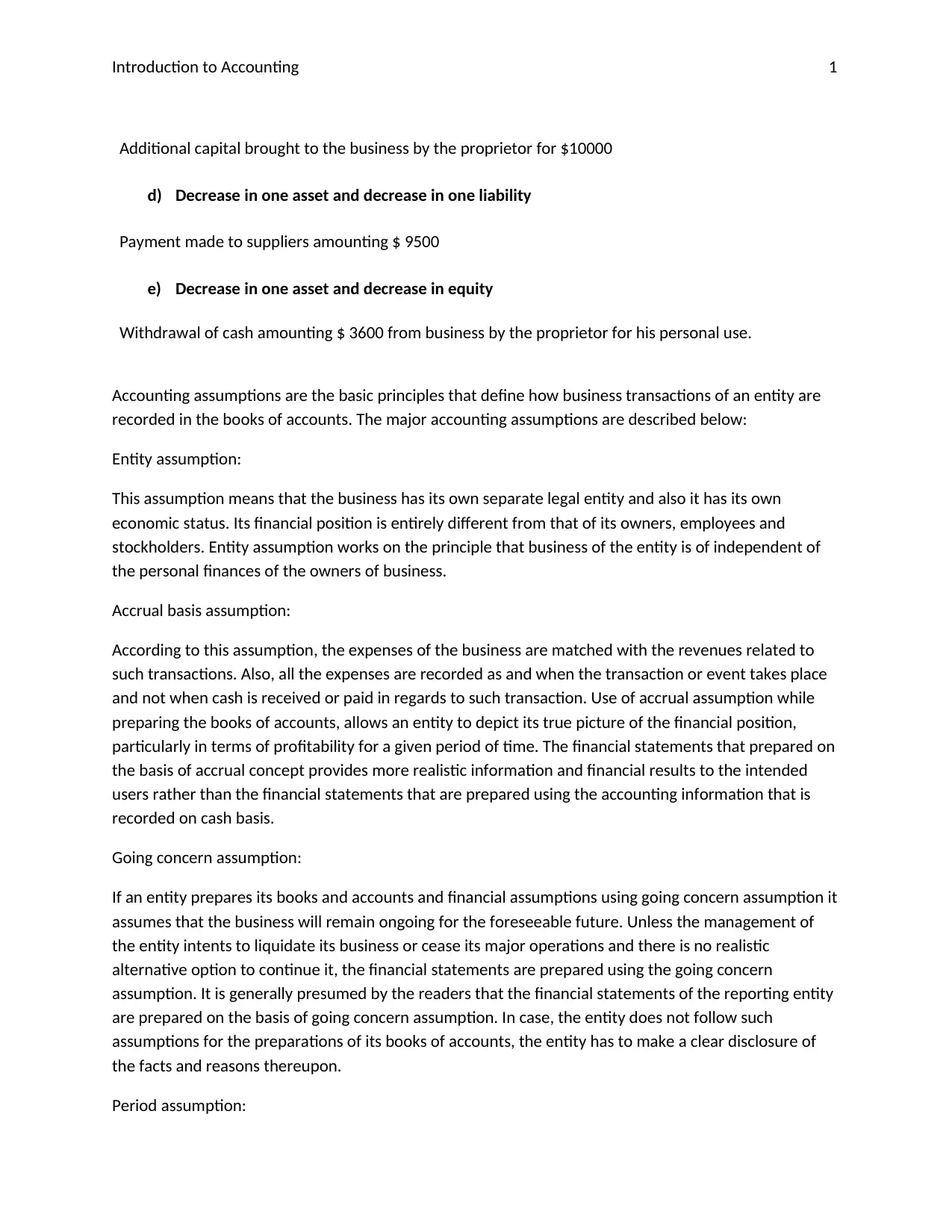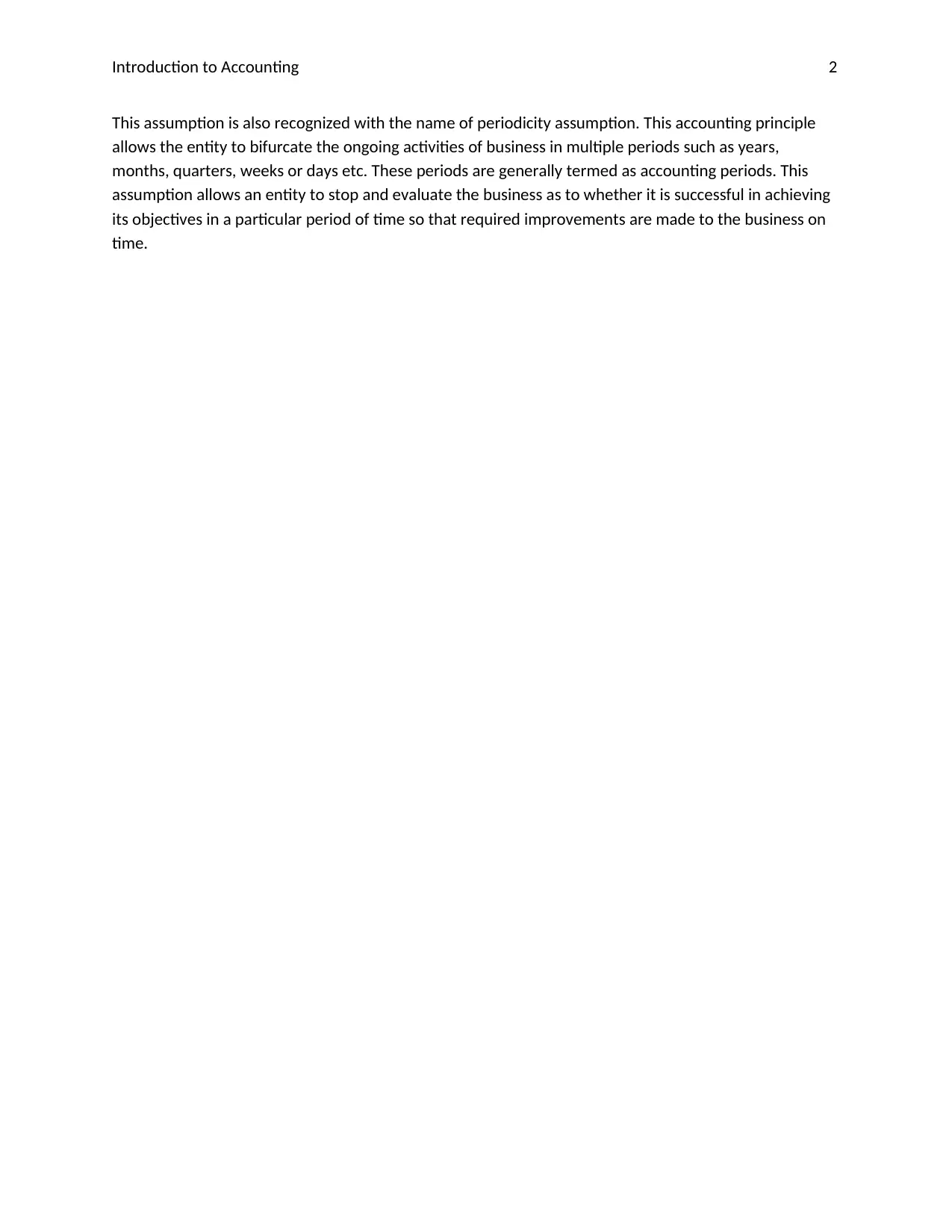Introduction to Accounting Problem 2.2 Part 3: Financial Reporting
VerifiedAdded on 2023/06/09
|3
|934
|477
Homework Assignment
AI Summary
This document provides a comprehensive solution to an accounting assignment focused on the relationship between income statements and cash flow statements, and the differences between them. The assignment explores the impact of various transactions on financial statements, including equipment purchases, customer payments, proprietor contributions, supplier payments, and proprietor withdrawals. It also details key accounting assumptions such as the entity assumption, accrual basis assumption, going concern assumption, and period assumption, explaining their significance in financial reporting. The solution offers clear explanations of each concept and provides practical examples to illustrate the accounting principles discussed.

Running Head: Introduction to Accounting
Problem 2.2
Part 3
The income statement and cash flow statement of the company depicts different but somehow related
information. Income statements shows the net profit earned or loss occurred by the company in its
business, as a final result, during a particular period of time. However, the cash flow statement shows
the net cash flows of the business in particular period of time. Income statements are generally
prepared on the accrual basis and hence it covers information relating to all the transactions such as
revenues, expenses, income or losses, taken place during the particular period, usually one year,
irrespective of the cash receipts and payments for such transactions. However, cash flow statement
bifurcate cash flows that take place in that particular period, majorly in three categories. They are:
operating activities, investing activities and financing activities. If any event or transaction has not
resulted in any cash inflow or outflow, then the same will not be reported by the cash flow statement.
Therefore, it can be said that cash flows provides information for the short-terms while income
statements offers the bigger picture of the business. They account for the financial aspects such as non-
cash expenses (depreciation) beyond the mere cash flows of business and hence they allow the users to
observe long-term trends of earnings as well as spending.
Thus, it can be said that income statements conveys the true picture of company’s financial situation,
particularly, its profitability state whereas cash flow statements does not shows the clear picture of
entity’s financial status.
Chapter 3
Discussion 6
a) Increase in asset and increase in liability
Purchase of an equipment of $15000 by using loan financing. This transaction will amount to increase in
fixed asset (Equipment) and increase in its liability (Loan).
b) Decrease in asset but no change in total assets
Payment received from the customer for $ 5000 for the trade credit given previously. It will amount to
decrease in the trade receivables of the company and the cash will also be increase by the same amount
of $ 5000. As cash is also an asset, this transaction will ultimately result in no changes in the overall
value of total assets.
c) Increase in one asset and increase in equity
Problem 2.2
Part 3
The income statement and cash flow statement of the company depicts different but somehow related
information. Income statements shows the net profit earned or loss occurred by the company in its
business, as a final result, during a particular period of time. However, the cash flow statement shows
the net cash flows of the business in particular period of time. Income statements are generally
prepared on the accrual basis and hence it covers information relating to all the transactions such as
revenues, expenses, income or losses, taken place during the particular period, usually one year,
irrespective of the cash receipts and payments for such transactions. However, cash flow statement
bifurcate cash flows that take place in that particular period, majorly in three categories. They are:
operating activities, investing activities and financing activities. If any event or transaction has not
resulted in any cash inflow or outflow, then the same will not be reported by the cash flow statement.
Therefore, it can be said that cash flows provides information for the short-terms while income
statements offers the bigger picture of the business. They account for the financial aspects such as non-
cash expenses (depreciation) beyond the mere cash flows of business and hence they allow the users to
observe long-term trends of earnings as well as spending.
Thus, it can be said that income statements conveys the true picture of company’s financial situation,
particularly, its profitability state whereas cash flow statements does not shows the clear picture of
entity’s financial status.
Chapter 3
Discussion 6
a) Increase in asset and increase in liability
Purchase of an equipment of $15000 by using loan financing. This transaction will amount to increase in
fixed asset (Equipment) and increase in its liability (Loan).
b) Decrease in asset but no change in total assets
Payment received from the customer for $ 5000 for the trade credit given previously. It will amount to
decrease in the trade receivables of the company and the cash will also be increase by the same amount
of $ 5000. As cash is also an asset, this transaction will ultimately result in no changes in the overall
value of total assets.
c) Increase in one asset and increase in equity
Paraphrase This Document
Need a fresh take? Get an instant paraphrase of this document with our AI Paraphraser

Introduction to Accounting 1
Additional capital brought to the business by the proprietor for $10000
d) Decrease in one asset and decrease in one liability
Payment made to suppliers amounting $ 9500
e) Decrease in one asset and decrease in equity
Withdrawal of cash amounting $ 3600 from business by the proprietor for his personal use.
Accounting assumptions are the basic principles that define how business transactions of an entity are
recorded in the books of accounts. The major accounting assumptions are described below:
Entity assumption:
This assumption means that the business has its own separate legal entity and also it has its own
economic status. Its financial position is entirely different from that of its owners, employees and
stockholders. Entity assumption works on the principle that business of the entity is of independent of
the personal finances of the owners of business.
Accrual basis assumption:
According to this assumption, the expenses of the business are matched with the revenues related to
such transactions. Also, all the expenses are recorded as and when the transaction or event takes place
and not when cash is received or paid in regards to such transaction. Use of accrual assumption while
preparing the books of accounts, allows an entity to depict its true picture of the financial position,
particularly in terms of profitability for a given period of time. The financial statements that prepared on
the basis of accrual concept provides more realistic information and financial results to the intended
users rather than the financial statements that are prepared using the accounting information that is
recorded on cash basis.
Going concern assumption:
If an entity prepares its books and accounts and financial assumptions using going concern assumption it
assumes that the business will remain ongoing for the foreseeable future. Unless the management of
the entity intents to liquidate its business or cease its major operations and there is no realistic
alternative option to continue it, the financial statements are prepared using the going concern
assumption. It is generally presumed by the readers that the financial statements of the reporting entity
are prepared on the basis of going concern assumption. In case, the entity does not follow such
assumptions for the preparations of its books of accounts, the entity has to make a clear disclosure of
the facts and reasons thereupon.
Period assumption:
Additional capital brought to the business by the proprietor for $10000
d) Decrease in one asset and decrease in one liability
Payment made to suppliers amounting $ 9500
e) Decrease in one asset and decrease in equity
Withdrawal of cash amounting $ 3600 from business by the proprietor for his personal use.
Accounting assumptions are the basic principles that define how business transactions of an entity are
recorded in the books of accounts. The major accounting assumptions are described below:
Entity assumption:
This assumption means that the business has its own separate legal entity and also it has its own
economic status. Its financial position is entirely different from that of its owners, employees and
stockholders. Entity assumption works on the principle that business of the entity is of independent of
the personal finances of the owners of business.
Accrual basis assumption:
According to this assumption, the expenses of the business are matched with the revenues related to
such transactions. Also, all the expenses are recorded as and when the transaction or event takes place
and not when cash is received or paid in regards to such transaction. Use of accrual assumption while
preparing the books of accounts, allows an entity to depict its true picture of the financial position,
particularly in terms of profitability for a given period of time. The financial statements that prepared on
the basis of accrual concept provides more realistic information and financial results to the intended
users rather than the financial statements that are prepared using the accounting information that is
recorded on cash basis.
Going concern assumption:
If an entity prepares its books and accounts and financial assumptions using going concern assumption it
assumes that the business will remain ongoing for the foreseeable future. Unless the management of
the entity intents to liquidate its business or cease its major operations and there is no realistic
alternative option to continue it, the financial statements are prepared using the going concern
assumption. It is generally presumed by the readers that the financial statements of the reporting entity
are prepared on the basis of going concern assumption. In case, the entity does not follow such
assumptions for the preparations of its books of accounts, the entity has to make a clear disclosure of
the facts and reasons thereupon.
Period assumption:

Introduction to Accounting 2
This assumption is also recognized with the name of periodicity assumption. This accounting principle
allows the entity to bifurcate the ongoing activities of business in multiple periods such as years,
months, quarters, weeks or days etc. These periods are generally termed as accounting periods. This
assumption allows an entity to stop and evaluate the business as to whether it is successful in achieving
its objectives in a particular period of time so that required improvements are made to the business on
time.
This assumption is also recognized with the name of periodicity assumption. This accounting principle
allows the entity to bifurcate the ongoing activities of business in multiple periods such as years,
months, quarters, weeks or days etc. These periods are generally termed as accounting periods. This
assumption allows an entity to stop and evaluate the business as to whether it is successful in achieving
its objectives in a particular period of time so that required improvements are made to the business on
time.
⊘ This is a preview!⊘
Do you want full access?
Subscribe today to unlock all pages.

Trusted by 1+ million students worldwide
1 out of 3
Related Documents
Your All-in-One AI-Powered Toolkit for Academic Success.
+13062052269
info@desklib.com
Available 24*7 on WhatsApp / Email
![[object Object]](/_next/static/media/star-bottom.7253800d.svg)
Unlock your academic potential
Copyright © 2020–2025 A2Z Services. All Rights Reserved. Developed and managed by ZUCOL.





